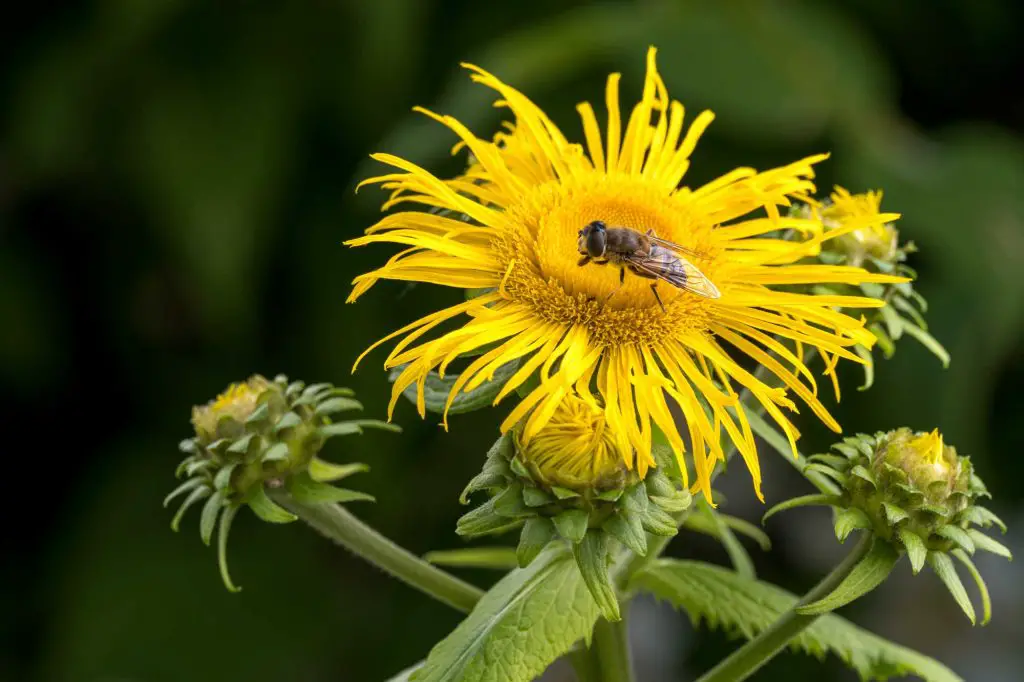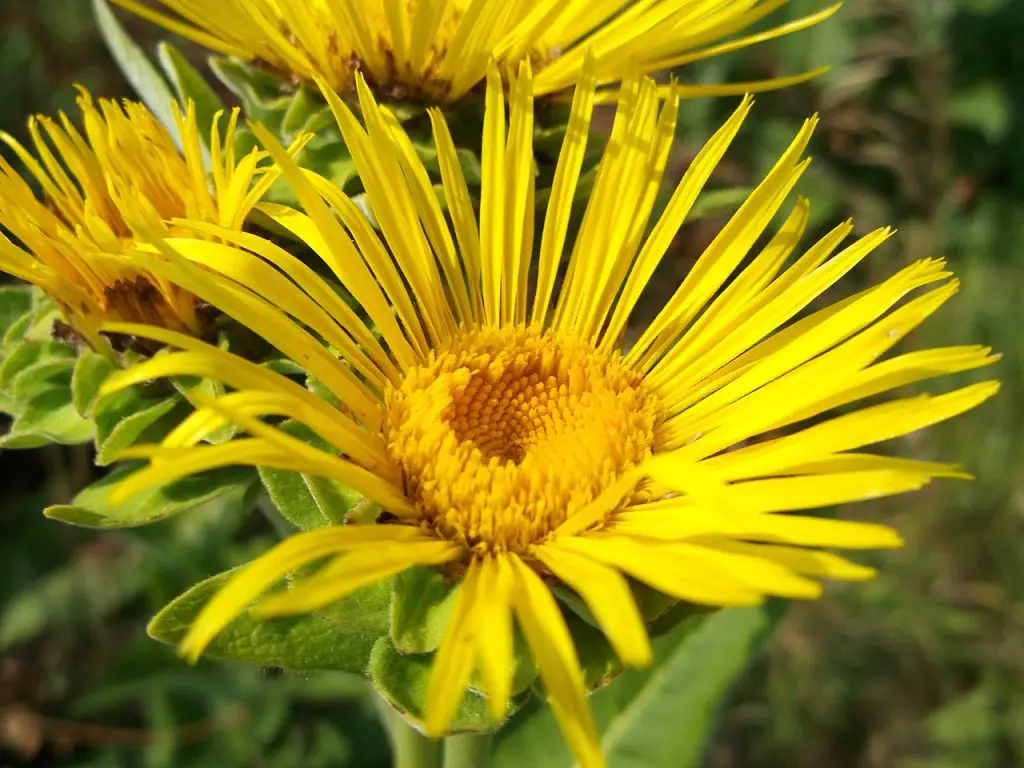What is Elecampane?
Elecampane (Inula helenium L.) belongs to the Asteraceae or Compositae family [1][2][3][4]. It has many names like elf dock, horse heal, elf wort, wild sunflower, yellow starwort, scab wort, inula, velvet dock, Elephant’s ear, and horse elder [2][3].
Our society knows the plant for its abundant beneficial roots and rhizomes [2][3]. Early writings suggest Elecampane comes from Old English ‘elene’ from Latin enula (genus) and Latin campanus which means ‘field.’ The specific epithet helenium is supposedly a direct reference to Helen of Troy [13][14][15].
This plant is native to Europe and Western Asia and has reached some regions of North America [4]. It is a non-woody biennial and perennial plant [2], hence may germinate, grow, and live up to over two years [1][2].
Elecampane grows up to 2 meters tall and thrives well in open woodlands, grasslands, and damp pastures [2][3].The plant has tooth-shaped leaves and small yellow daisy-like flowers [1][2][3].
The ancient Greeks and Romans [11] cultivated and widely used Elecampane as a medicinal plant for indigestion and skin infections [4][5][6]. The herb became famous as a diuretic drug in other European countries, while the natives in America used them to treat lung ailments. [4][5].
Earliest civilization further shows the benefits of Elecampane, concentrating its usage on the plant’s dried roots and rhizomes [6][7][9].They value aromatic tonics and concoctions from the plant to stimulate and improve the human body system [4][6][8].

Elecampane Root Benefits and Uses
Elecampane has a long recorded history of being an essential plant [7][9]. Western civilization traditionally uses it as medicine to treat respiratory-related diseases. Elecampane performs as an antimicrobial and stimulant and is still popular today with people interested in natural remedies [4][9][10]. Elecampane is also used to flavor sweets and candies [6][9].
Essential elements [7][14][20] of Elecampane are inulin, helenanin, helenin, sesquiterpene lactones (including alantolactone and isoalantolactone), phytosterol, B and y- sitosterol, friedelin, alantic acid, and azulin [23]. All these diverse compounds contribute to the effectiveness of this herbal plant.
Improve respiratory health
Elecampane is a well-known natural remedy and antiseptic [9] for asthma, bronchitis, pneumonia [20], sinusitis and cough [5][6][7]. When infused with other herbal plants, this herb can improve coughing conditions by soothing the irritation and inflammation of the lungs and throat [9][17][18].
Phytochemicals [11] work as an expectorant [7][9]. Elecampane thins and loosens mucus in the airways, cleansing the congestion symptoms, and making breathing more comfortable [9]. Europeans historically used Elecampane for treating tuberculosis bacillus that causes the disease [12][19].
Elecampane also contains sesquiterpene lactones which have calming and antioxidant properties vital for treating bacterial respiratory infections [7]. This natural compound boosts the human immune system and helps repair cells damaged by harmful microbes [11][24].
Looking for other types of herbs for respiratory health? Read about Mullein and Osha Root.
Antimicrobial, Antibacterial and Antifungal
Researchers have investigated the bioactive compounds in selected species of pathogenic bacteria and fungi [22][23]. Studies showed that extracted ethanol from Elecampane cultivar roots significantly displayed antimicrobial activity for 8 out of 9 microorganisms [23].
Another recent study conducted a phytochemical analysis of elecampane roots [23]. Researchers confirmed Elecampane can work against harmful pathogens [23] and alantolactone has a great potential in treating gram-positive bacteria that cause diseases in the lungs and skin [22].
Researchers similarly observed the inhibitory effects of Elecampane against fungi. A 2014 finding showed the complete inhibition of a fungal enzyme when tested in the presence of Elecampane roots [26].
This information strongly supports why the historic times used creams from Elecampane for relieving skin irritations [4][9] and wounds of horses and livestock [19][20]. Even Hippocrates used Elecampane to treat chronic skin rashes, itching, and pain from animal bites [11][13][15].
Antiparasitic
There is evidence that the compounds alantolactone and isoalantolactone present in elecampane roots are effective in controlling animal parasites [4][6][9][22] and intestinal worms- roundworms, pinworms, threadworms, and hookworms.
Anti-infammatory
Inula works against infections and inflammation [6][7][9]. Phytochemical compounds present in elecampane are anti-inflammatory [22][24].
Improve digestive health
Tonic herb derived from elecampane roots help in digestion [7][8], heartburn, and stomach acidity [4][5][9]. Elecampane concoction triggers peristalsis, and promotes a relaxing feeling in the stomach [18][19].
Elecampane roots are abundant in inulin substances that nourish colon cells and keep the gut healthy [6], and even relieve constipation [8][10]. In fact, a 2019 research showed the suitability of Elecampane as a feed additive in broiler chicken to boost performance and intestinal health [25].
Treat urinary tract infection
The Elecampane plant stimulates blood flow in the pelvic area and the uterus [12]. They help improve the urinary system and facilitate kidney function [13].
Antidiabetic
Elecampane appears to have a positive effect on people with diabetes [8]. A high level of inulin denotes a reduction of sugar metabolic activity, lessens inflammation associated with this condition, and normalizes irregular blood sugar [12].
A study shows chemical ingredients B and y- sitosterol, stigmasterol, friedelin, alantic acid, and azulin are significantly present in elecampane roots. These compounds work against diabetes [13].
Anticancer properties and cardiovascular fitness
The main active constituents in Elecampane are sesquiterpene lactones and triterpenoids [13]. Herbalists assumed these compounds help treat cardiovascular diseases and fight inflammation and other symptoms of cancer [13]. Investigation of these phytochemicals [22] reinforced their anticancer properties.
Food and beverages flavoring
Elecampane is rich in inulin; a substance isolated by a German scientist from the same plant in the year 1804. Inulin is a prebiotic fiber that aids in weight loss, improves gut health, and supplies additional nutrients to the human body [9][10][24].
France used it for absinthe, an alcoholic drink popular during the late 19th to early 20th century. They also once produced it as lozenges for relieving cough symptoms [15].
Similarly, Elecampane roots are mixed with cinnamon and nutmeg to make sweet foods like cakes and pastries [6][9]. Some sources [18] also cited a 14th-century Italian cookbook containing a sweet and sour fish recipe infused with the root.
The Council of Europe listed the plant as a natural flavor for food [9]. The study on root-essential oils additionally revealed a promising impact of bioactive components of Elecampane as flavor and additive [22].
Therapeutic
Because of some active compounds naturally present in Elecampane [12][13], the root extracts can be a curative option for chronic fatigue. The herb has antioxidants that prevent further damage to cells and fight stress [18][24].
Perfume and essential oil
Roots of Elecampane are a source of camphor scented essential oil [6][21]. The conducted study cited above further proposed the potential of root-essential oils to perfume industries [22].
Elecampane Dosage
One can prepare extracts from Elecampane roots as syrup, powder, decoction, or tincture [6][12][13][14]. The dosage of Elecampante depends on several reasons. The user’s age, health, and conditions may affect the quantity and frequency of dosage.
Below are the means of preparing the Elecampane herb:
Elecampane root tea
Take 2 tbsp of dried roots. Boil and simmer for 20 minutes. Transfer the boiled water in a cup and add honey or any sweetener to balance the bitter taste.
Elecampane roots tincture
Root extracts that resulted from soaking the roots in alcohol or vinegar are called a ‘tincture’. The user can take root tincture 2 to 3 times per day, or as directed by an herbalist. Other herbalists recommend taking one dose of 15 to 20 drops 4 to 5 times a day. Another one prescribed 30 to 90 drops 4 to 6 times per day.
Decoction of roots
Beneficial components from Elecampane roots are perfect for external application to skin conditions and itching. Prepare and soak 1 oz (30 grams) of dried roots in 1 quart (1 liter) of water.
Use a clean cloth when dipping into the decoction. Apply to the infected area 2 to 3 times a day.
Dried root powder
Oral take up of Elecampane powder is 1 to 4 grams a day. The syrup form, shall be taken at 15-60ml.
Infusion or tonic drink from leaves
Prepare 50 grams of plant leaves. Boil 1 liter of water and toss the plant inside the heating pot. Let it simmer for 15 minutes. The recipient can take the infusion 2 to 6 cups a day.
Decoction of leaves
Soak the leaves in 1 liter of water. You can take a cap before each meal.
Another reminder is to dose elecampane at smaller frequent amounts for acute coughs.
To strengthen the efficacy of Elecampane, comprehensive and scientific information is required to determine the exact dosage or recommendation for everybody. Consulting your physician is still the sensible way to prevent undesirable outcomes.
Elecampane Side Effects, Safety and Warnings
Elecampane does not exhibit dangerous side effects if taken according to the recommended dose. However, excessive amounts of Elecampane may cause paralysis, diarrhea, vomiting, spasms, and cramps [6].
They may also cause nausea and drowsiness. Medical professionals cautioned the plant to individuals with an allergic reaction to the Asteraceae family.
Elecampane allegedly can stimulate the uterus and trigger contractions, which is why they may not be suitable for pregnant and nursing mothers [4].
Please consult a healthcare professional before using Elecampane as an alternative medical remedy [7].
Final Thoughts
Antibiotics and many modern-day medications depend on alternative herbal plants that contain promising active compounds. Results and experimentations evolve to provide us the best care possible- free from pains and troubles!
Despite the many benefits of any herbal plant, such as Elecampane, one must always exercise caution and administer only the suggested amount.
Elecampane can be potent and may cause unwanted effects, hence further assessment and evaluation of its effects are necessary.
Frequently Asked Questions
What does Elecapane smell like?
Experts and people familiar with Elecampane portray it as pungent, sweet-smelling, aromatic, and camphor-like [12][19].
What does Elecampane taste like?
Elecampane has a bitter taste that lingers. Users combined it with sweetened syrup to make it palatable.
Is Elecampane safe for dogs and cats?
Studies consistently support Elecampane to contain antitussive and antimicrobial properties [20][27].
One research in Romania directly provides that dried roots of the Elecampane plant have the potential to ward off pathogenic bacteria and fungi.
There are also pet lovers who further advise Elecampane is a safe herb for treating the respiratory conditions of dogs and cats. Only use the plant rhizomes to produce a decoction or tincture.
As a general rule, consult a veterinarian before giving any herbal medicines to your pets.
References:
[1] http://www.omafra.gov.on.ca/english/crops/facts/ontweeds/elecampane.htm
[2] https://www.rhs.org.uk/plants/9171/inula-helenium/details
[3] https://hort.purdue.edu/newcrop/HerbHunters/elecampane.html
[4] https://www.herbcottage.com.au/products/elecampane
[5] https://www.peacehealth.org/medical-topics/id/hn-2083001
[6] https://www.webmd.com/vitamins/ai/ingredientmono-2/elecampane
[7] https://www.floraforce.co.za/herb-library/elecampane/
[8] https://www.medicalnewstoday.com/articles/318593#Other-potential-benefits
[9] https://pfaf.org/user/Plant.aspx?LatinName=Inula+helenium
[10] https://health.clevelandclinic.org/inulin-benefits/
[11] http://ccras.nic.in/sites/default/files/viewpdf/jimh/BIIHM_1998/7%20to%2012.pdf
[12] https://www.herbalremediesadvice.org/elecampane-uses.html
[13] https://www.nature-and-garden.com/health/inula-hellenium-health-benefits.html
[14] https://www.indigo-herbs.co.uk/natural-health-guide/benefits/elecampane
[15] https://www.missouribotanicalgarden.org/PlantFinder/PlantFinderDetails.aspx?taxonid=277211
[16] https://phytology.org.uk/plants/elecampane/
[17] https://www.sciencedirect.com/topics/medicine-and-dentistry/elecampane
[18] https://blog.metmuseum.org/cloistersgardens/2010/07/13/elecampane/
[19] https://www.herbalreality.com/herb/elecampane/
[20] https://rawfoodforpets.com/kb-faq/elecampane/
[21] https://perfumesociety.org/ingredients-post/elecampane/
[22] https://www.ncbi.nlm.nih.gov/pmc/articles/PMC8197530/
[23] https://e-repository.org/rbl/vol.19/iss.5/7.pdf
[24] https://japsonline.com/admin/php/uploads/2440_pdf.pdf
[25] https://www.sciencedirect.com/science/article/abs/pii/S1871141318304141
[26] https://www.sciencedirect.com/science/article/abs/pii/S0926669020302892






